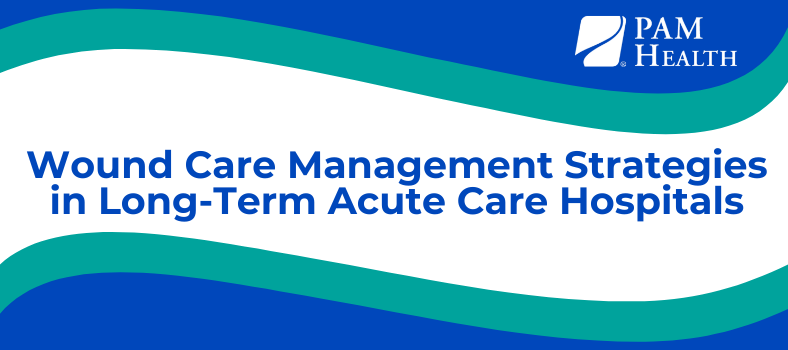
For patients in specialty hospitals (LTACHs) whose diagnoses include complex wounds, a multidisciplinary approach to their care is imperative to promote wound healing and manage their other advanced medical needs.
Explore Health Services Offered by PAM Health
What is a “complex wound?”
Complex wounds are defined as wounds that stall in the healing process and do not progress through the typical stages of healing. Complex wounds should possess at least one of the following characteristics:
- Persistent for more than three months
- Compromised blood flow or necrosis (dying tissue)
- Presence of infection
- Associated comorbidities that impair the body’s ability to further healing1
Wound care strategies in a Specialty Hospital
“We have access to an extensive wound care formulary providing advanced wound healing based on evidence-based research,” said. Glenna Fanning, PAM Health’s Corporate Director of Wound Care. One wound care technique that PAM Health specialty hospitals use is sharp debridements, with the capability of doing them bedside if the patient is not mobile, common in specialty hospitals, said Fanning. Sharp debridement involves using surgical tools to remove infected nonviable tissue to promote healing and the regrowth of healthy tissue.2
Each specialty hospital also has the ability to perform negative pressure wound therapy using vacuum-assisted closure devices (VACs) to assist with wound closure, Fanning said. This is when the VAC, a suction device, is placed over a specialized wound dressing.3
Other advanced bedside wound care and select wound care modalities may be available on a case-by-case basis at certain hospitals. Other strategies may include:
- Hyperbaric oxygen therapy (HBOT)
- Bioengineered skin substitutes
- Specialized wound care products
- Advanced wound dressings
Both HBOT and bioengineered skin substitutes require a patient meet specific, unique criteria before each treatment is initiated and are usually done in an outpatient setting. For example, one benchmark for a patient to be considered for HBOT is having achieved optimized circulation so that the oxygen-rich blood the hyperbaric chamber helps promote can travel to wounds in lower extremities.
Dealing with complex wounds in a specialty vs. rehab hospital setting
Often, patients in a specialty hospital are severely debilitated and require ongoing nursing and medical care. They may be fully or partially dependent for mobility, self-care, and other activities of daily living. They may also require IV medications and advanced respiratory and nutritional support if they can’t breathe or eat on their own. Add complex wounds into the mix, and the level of care required to help patients progress toward returning home healthy is intensive and specialized.
“In working with medically complex patients and to provide maximum wound care healing, [PAM Health hospitals] provide an interdisciplinary approach to the delivery of care. We work closely with respiratory, dietary, therapy, and dialysis, as well as with all specialist providers, to ensure that all aspects of patient care are taken into consideration,” Fanning said.
Fanning added that these other aspects of patient care contribute to a wound’s ability to heal, including a patient’s oxygenation, nutrition, strength, and mobility. “Wound healing is not limited to the dressing or the treatment that we provide topically…which is why it is crucial to work together as a team to provide the best care possible,” Fanning said.
While wounds might not fully heal while a patient is in a specialty hospital, wound care staff will employ healing techniques tailored to the unique needs of a patient that will prevent worsening of a wound and promote faster healing over time.
“Our ultimate goal would be to see our patient's wounds have maximum health, including closure,” says Fanning. “However, the extensive nature of many of the wounds that our patients are admitted with allows us to begin the wound health process during their hospitalization in order to set the path for maximum wound healing during their hospital continuum journey.”
Patients with complex wounds in a rehabilitation setting, on the other hand, while still recovering from an illness or injury, are able to participate in therapy for at least three hours per day, five days per week. The same approach to wound care strategies in specialty hospitals carries over to inpatient rehab: a tailored, best-practice approach unique to each patient’s needs. After a patient completes inpatient rehabilitation, transitioning to outpatient care ensures continued monitoring until full wound closure and healing are achieved. In an outpatient wound care setting, patients may receive less invasive wound care treatments such as hyperbaric oxygen therapy and will learn how to care for their wounds at home in between appointments.
“In general, the wound care/healing at all three locations [specialty hospital, inpatient rehab, and outpatient rehab] is very similar,” says Fanning. The differences mainly stem from the type of wound and whether the patient is inpatient or outpatient, she said.
Luckily, PAM Health’s Specialty Hospitals around the country are equipped to not only handle patients’ delicate medical needs including wounds, but also jumpstart their rehabilitation with therapy. Learn more about our specialty wound care program and how it fits with our overall approach to a patient’s healing journey.
Find a PAM Health Location Near You
Bibliography:
1Labib A, Winters R. Complex Wound Management. [Updated 2023 Jul 4]. In: StatPearls [Internet]. Treasure Island (FL): StatPearls Publishing; 2024 Jan-. Available from: https://www.ncbi.nlm.nih.gov/books/NBK576385/
2Manna B, Nahirniak P, Morrison CA. Wound Debridement. [Updated 2023 Apr 19]. In: StatPearls [Internet]. Treasure Island (FL): StatPearls Publishing; 2024 Jan-. Available from: https://www.ncbi.nlm.nih.gov/books/NBK507882/
3Zaver V, Kankanalu P. Negative Pressure Wound Therapy. [Updated 2023 Sep 4]. In: StatPearls [Internet]. Treasure Island (FL): StatPearls Publishing; 2024 Jan-. Available from: https://www.ncbi.nlm.nih.gov/books/NBK576388/